Published by Medium on Oct. 1, 2018
After escaping ISIS, young Yazidi women are learning to fight, thanks to a retired Green Beret
All photos by author.
DUHOK, IRAQ — Rojin* closes her eyes. She knows it’s coming. Suddenly, she’s shoved sideways. She responds with force, laying down powerful punches with her palms out as her attacker absorbs the blows. She numbers the strikes in Kurmanji: “Yek, du, sê, çar!” she shouts. Thwack, thwack, thwack, thwack.
“Good,” says her instructor, 37-year-old Cassie Rhodes, moving down the line to the next student.
It’s late August, and we’re in a refugee camp in Northern Iraq that we will not name for security reasons. Rojin, 17, is learning Krav Maga, a self-defense system developed by Jewish athlete Imre Lichtenfeld, in 1930s Czechoslovakia as a way to help his neighbors protect themselves amid widespread anti-Semitic riots. Today, the Israeli Defense Forces trains all of its soldiers in the discipline.
“They were beating me, raping me, doing everything bad.”
Rojin, an ethnic Yazidi, also knows what it’s like to be targeted for her religion. At 14, she was abducted, along with seven of her sisters, by ISIS fighters who had laid siege to her hometown of Sinjar. It was the beginning of a three-and-a-half-year ordeal.
“They were beating me, raping me, doing everything bad,” she told me, as we stood outside the training tent, at a distance from her classmates. She looked away timidly, speaking through a translator. Asked about the day ISIS arrived, she demurred. “I don’t want to remember that. I just want to forget some things that happened.”
Rojin repeatedly attempted to escape, without success, and was punished severely by her captors. “They beat me so badly,” she recalled. “I have to be stronger. I have to be able to fight back if they come for us again.”
It’s the first day of training, and 20 young pupils are lined up in a massive tent with plywood floors. Ten Iranian-made air-conditioning units are scattered around the back of the room. None are plugged in. Outside, the heat peaks at 110 degrees. Inside, with no ventilation, it’s sweltering.
Retired U.S. Army Green Beret Jeremy Moore makes his way around the room holding a tombstone-shaped strike pad, absorbing punch after punch from Rojin’s classmates.
“Nice!” he says, shoving the pad at each girl in turn. “Again!”
They don’t speak English, but they get the point.
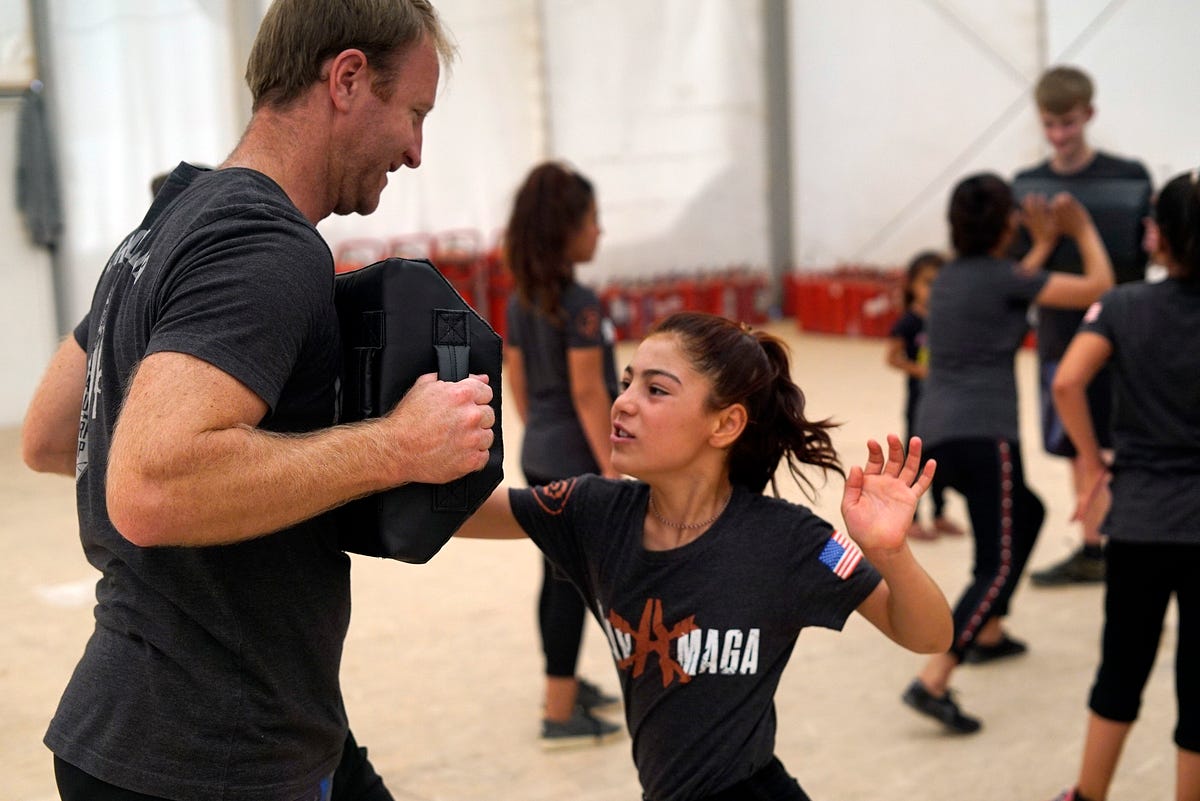
This is not Moore’s first time in Iraq. Between 2003 and 2014, he deployed here five times, conducting special operations throughout the country before retiring in 2016. “We’ve lost a lot of friends here,” he says. Now on a mission of his own, he has brought a team of Krav Maga instructors, including Cassie Rhodes and his 16-year-old son, Joshua, on a two-week trip, instructing Rojin and hundreds of other Yazidi women and girls on skills like escaping a chokehold and kneeing someone in the groin.
Rojin is sweating, but she looks delighted, a seemingly happy teenager, smiling and snapping selfies with her classmates.
“I feel powerful,” she tells me during a water break. “The main reason why I want to learn is for the future. If someone wants to enter inside my tent with a knife to kill us, we can defend ourselves.”
This camp for so-called internally displaced persons is home to 15,000 Yazidis, uprooted by ISIS in a brutal assault that shocked the world. The attacks began in mid-2014, just a month after the Islamic State proclaimed itself a caliphate. The militants were notoriously ruthless, but their treatment of the the Yazidis, whom they called devil worshipers and infidels, was remarkably savage.
An estimated 5,000 Yazidi men were massacred; some 7,000 Yazidi women and girls were abducted and pressed into sexual slavery, treated as spoils of war. Nearly four years later, around 3,000 — including one of Rojin’s sisters — are still missing. Those working to bring them home estimate anywhere from one to 2,000 may still be alive and still in the hands of the remnants of ISIS.
Residents here long ago stopped relying on their fellow Iraqis to defend them.
Nonetheless, convincing the young women’s family members to allow them to participate in the class was sometimes challenging. Before the training began, Moore visited Rojin’s father in the family tent to seek his blessing. Lengthy grape vines snaked around the tent poles, a sign of their long stay in the camp.
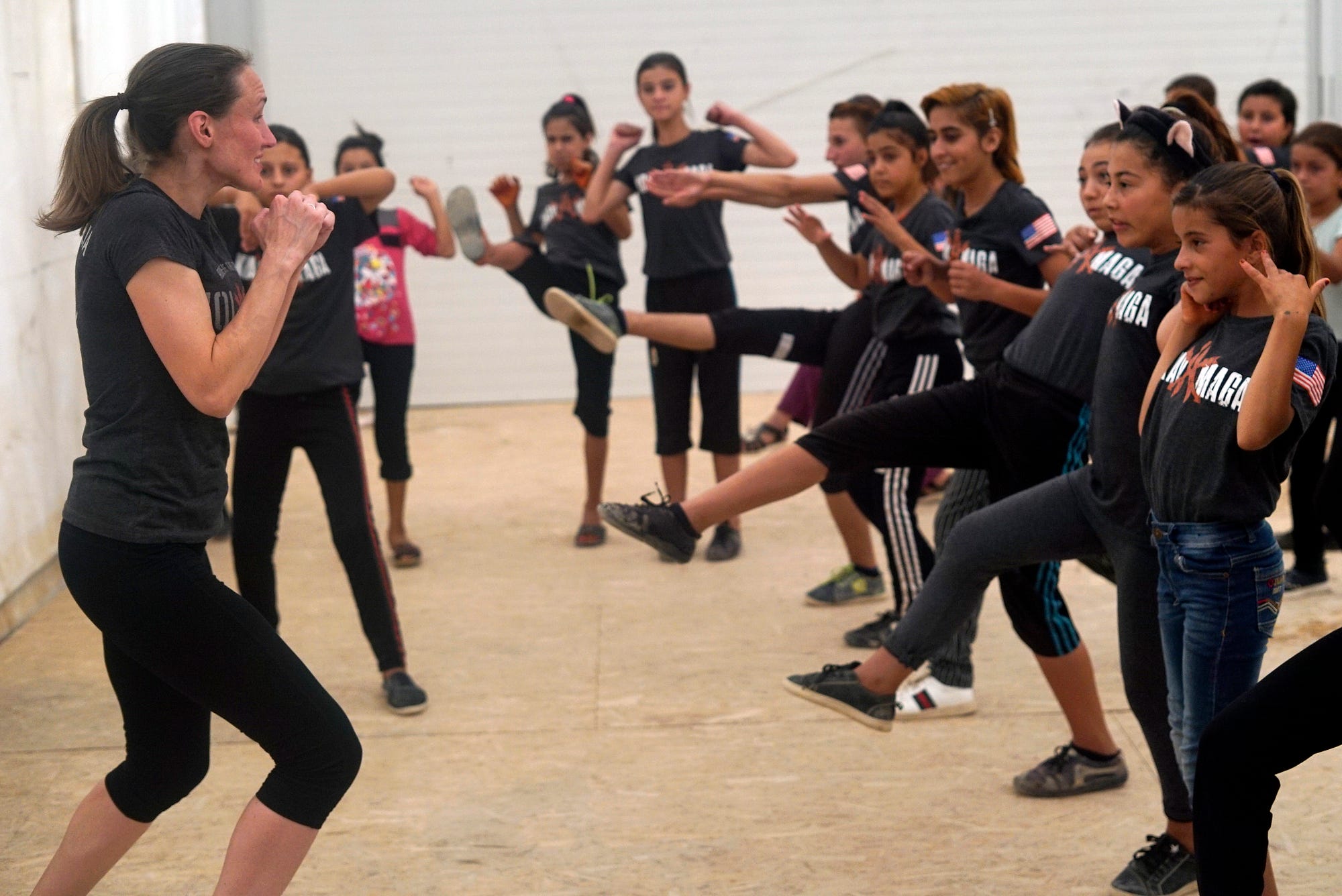 “I’m afraid of sending my family any distance away from me,” the man admitted, puffing on a thin cigarette. “I feel like I have aged so much these past four years,” he added. Since 2014, he has paid tens of thousands of dollars in ransom for ISIS fighters to return his family members, one by one. He remains terrified that they will come for his family again. “ISIS can even pay someone to burn down our tent,” he said.
“I’m afraid of sending my family any distance away from me,” the man admitted, puffing on a thin cigarette. “I feel like I have aged so much these past four years,” he added. Since 2014, he has paid tens of thousands of dollars in ransom for ISIS fighters to return his family members, one by one. He remains terrified that they will come for his family again. “ISIS can even pay someone to burn down our tent,” he said.
Moore promised him that his daughters would not leave the camp, adding that self-defense skills might one day save their lives. Though the danger seems remote at the moment, residents here long ago stopped relying on their fellow Iraqis to defend them.
“I trust you and know you will help me,” the father replied, giving his assent.
Moore grew up in a small farming community in northern Kansas, enlisting in the Army in 1996.
“I loved every second,” he tells me of serving in Special Forces. Well, not every second. “There’s lots of, like, ‘Life sucks. This is really cold, wet and miserable’.”
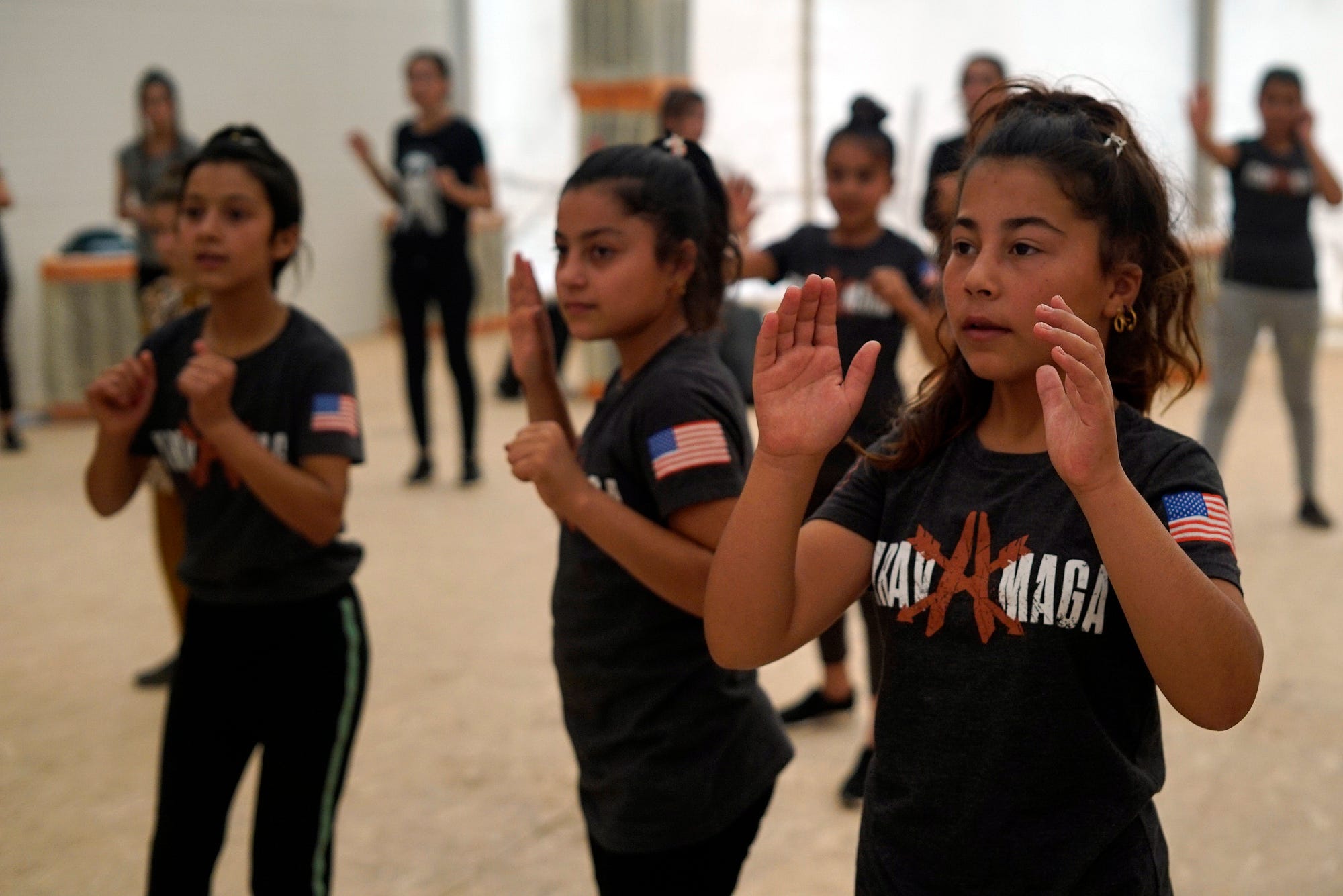 One of the low points, he says, was his last deployment to Iraq in 2014. “We were there, seeing ISIS sweeping through all these different areas, lining people up, killing them and taking women to be raped,” he recalls. “But, we didn’t have the authority to drop bombs, to do our job, to protect people. We sat by and allowed a genocide to be committed,” he says.
One of the low points, he says, was his last deployment to Iraq in 2014. “We were there, seeing ISIS sweeping through all these different areas, lining people up, killing them and taking women to be raped,” he recalls. “But, we didn’t have the authority to drop bombs, to do our job, to protect people. We sat by and allowed a genocide to be committed,” he says.
After retiring in 2016, Moore eschewed the usual path for a veteran with his experience; he turned down security contracting offering more than $1,000 per day. Instead, he traveled throughout Somalia, Iraqi Kurdistan, Ethiopia, and Kenya, looking to make positive difference in the world’s most troubled regions.
“I thrive in conflict zones,” he explains. “The United States is boring to me. I love America and bacon cheeseburgers. But this is where I’m the most comfortable and effective and can have the most impact.”
Earlier this year, Moore paid a visit to one of the interpreters he’d worked with in Iraq, a 41-year-old Yazidi man named Aezdin, and learned about the mistreatment of Yazidi women at the hands of the Islamic State, Moore mentioned that he’d been learning Krav Maga with his son. “That’s exactly what we need,” Aezdin said.
Before long, Moore was pitching his idea to a possible student. “Here I am, talking to a survivor of ISIS, raped multiple times, beaten, escaped,” he recalls. “I would just show her a video of my son training back in the United States and ask, ‘Would you like to learn this? Do you want to learn how to defend yourself?’ Her eyes lit up.”
In Krav Maga, you learn to hit and get hit right away. At its core, the discipline is all about gaining a fighting spirit.
Moore grows misty telling the story. He pauses, looking down. “I’m good,” he says after a moment and continues the story, recalling how he’d polled camp residents to see how many young women might participate in the training. He heard the same thing again and again. “All of them.”
Moore is now working on creating his own non-profit to “rescue girls and teach them to kick ass,” he says. Meanwhile, the training is run through Jeremy’s non-profit Volatile Charities, which works on projects in conflict or post-conflict regions, and another non-profit called The Guidry Foundation.
Much as he thrived in the Army, Moore says working on his own suits him. “There’s only one person in my chain of command — that’s my wife,” he says with a smile.
Onthe second day of training, 60 girls show up for class — triple the number versus the day before. Word has been spreading around camp. The next day, it’ll be 90. The girls, some as young as five or six, others up to 18, are nearly touching shoulders in three long rows. Many are wearing black “Krav Maga” T-shirts, each bearing an American flag on one sleeve, distributed the day before.
“Good morning, ladies!” Rhodes yells out.
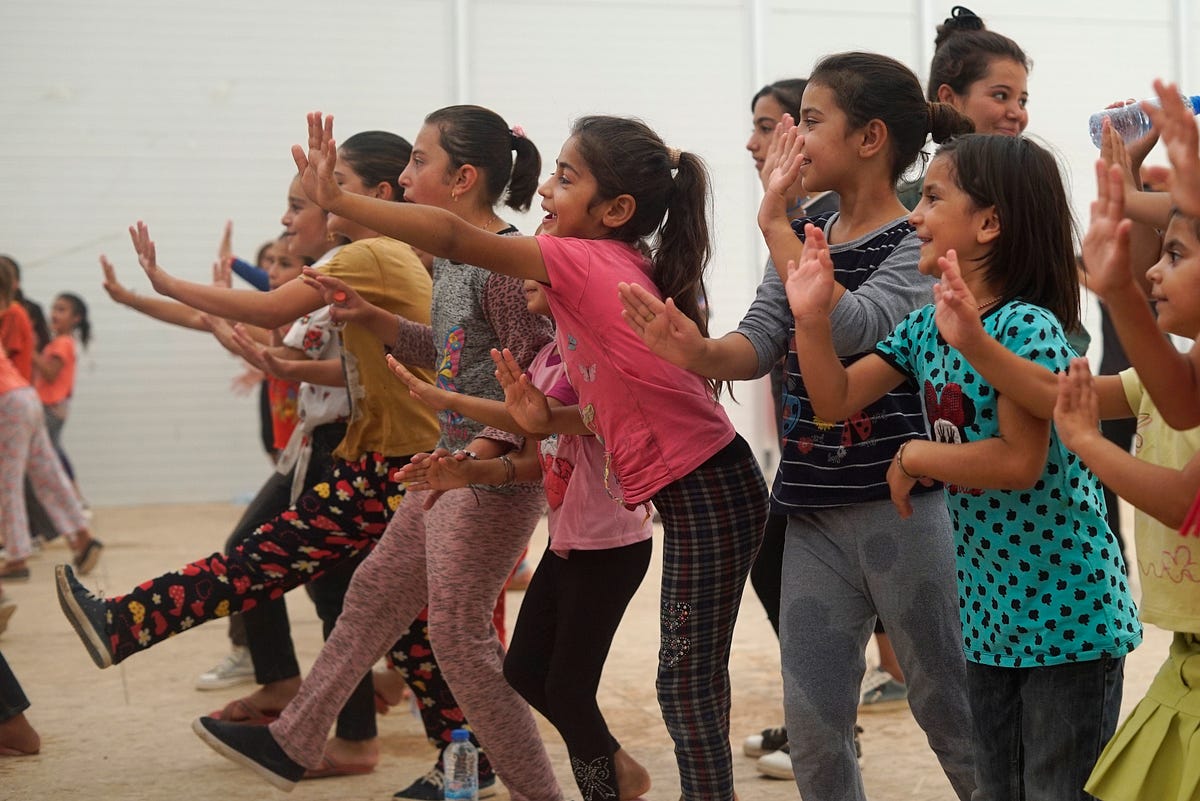
After some stretching, she instructs each one to find a partner of the same height, grab a pad, and practice strikes. “Make contact with the heel of your hand and rotate it slightly toward your thumb,” Rhodes says. “The pad will protect you.”
In Krav Maga, you learn to hit and get hit right away. At its core, the discipline is all about gaining a fighting spirit. There are no rules to the sport, since there are none in the real world. It’s intended to be practical — teaching participants to cause harm to an attacker and protect themselves however they can.
Rhodes is thin and fit. At one point, with about 10 girls clustered around her, she rolls up her sleeves to show her muscled upper arm. The girls smile and reach out to touch her biceps. Then they make a fist and bulge their own muscles. “You’re strong!” Rhodes tells them. (She later admits she was embarrassed to be the center of attention but was proud to show the girls that “women can be anything they want to be, including muscular.”)
 Back in North Carolina, Rhodes has taught Krav Maga self-defense techniques to survivors of rape and abuse. Some young women go through the course before heading off to college for the first time. “Women are vulnerable all over the world,” she tells me. “It’s always in the back of your mind.”
Back in North Carolina, Rhodes has taught Krav Maga self-defense techniques to survivors of rape and abuse. Some young women go through the course before heading off to college for the first time. “Women are vulnerable all over the world,” she tells me. “It’s always in the back of your mind.”
When Moore invited her to come to Iraq, Rhodes says, she didn’t hesitate, despite the dangers. The real challenge, she has found, is grappling with the immense suffering her students have endured. “You just want to cry, because it’s so terrible,” she says. “But it’s not your place to cry. It’s their story, and you’re there to listen.”
“This is an entire community that has been collectively traumatized.”
In class, Rojin’s kicks are soft and weak at first. She laughs at herself. Standing in the front of the room, Rhodes reminds the girls to be aggressive. “It’s important that you don’t stop hitting them until they leave you alone,” she says. In the next round, Rojin’s smile drops and her eyes focus. She kicks with serious force.
Culturally, it can be seen as shameful for women and girls to exercise publicly, Aezdin told me. Having Rhodes lead the training has helped to break that taboo.
“Nice job, ladies! Nice job!” she tells the girls as they wrap up their 45-minute session. “You are very, very strong.”
According to Dr. Anne Speckhard, an adjunct associate professor of psychiatry at Georgetown University’s School of Medicine, who has been working in the field of post-traumatic stress disorder since the 1980’s, trauma “lives in your body,” as she puts it.
“So, in this case, you’re teaching the body, ‘I can get this guy off of me. I’m strong. I can get away’,” she continues. “And that’s huge.” The goal is to rewrite the subject’s internal narrative. (Disclosure: I work with Speckhard on a project countering ISIS propaganda through her non-profit research organization.)
 Although Rojin and her sisters are the only girls at the training who have been abducted, everyone suffered hardship and terror. “I’m really afraid of ISIS still,” one 17-year-old participant tells me after class. She’s wearing a green shirt with a big red rose embroidered into it. “They could still attack us.”
Although Rojin and her sisters are the only girls at the training who have been abducted, everyone suffered hardship and terror. “I’m really afraid of ISIS still,” one 17-year-old participant tells me after class. She’s wearing a green shirt with a big red rose embroidered into it. “They could still attack us.”
“If someone wants to enter inside of my tent with a knife to kill us, we can defend ourselves.”
Indeed, although ISIS has lost nearly all of its territory in Iraq and Syria, pockets of fighters are still holding out in a few cities, including Mosul, just twenty or so miles away from the camp.
“This is an entire community that has been collectively traumatized,” Speckhard says. “And this is a trauma that has not yet ended. Hundreds of Yazidis, among others, are still in ISIS captivity, and their loved ones know what’s happening to them. Parents, sisters, brothers, cousins have to live with this horrible reality.”
Onthe final day of training, Rojin is in her family’s tent, her hands bound behind her back with a scarf. Her sister has tied her up the same way her ISIS captors did. “She has to get out by herself,” Moore says. At their request, he has offered the girls some additional pointers on how to escape such a scenario. After perhaps 30 seconds, Rojin, who has a jeweled pink barrette in her hair, twists her arms one final time and breaks free. She pumps up with excitement, then hugs her sister.
Then Rojin shares an additional detail of her ordeal. During parts of her captivity, she says, she was actually bound with chains around her arms and neck, meaning that even her newfound skills might not have made a difference. It’s a sobering reminder that for all of Moore’s efforts, the sort of evil directed against Rojin and her fellow Yazidis is not easily overcome.
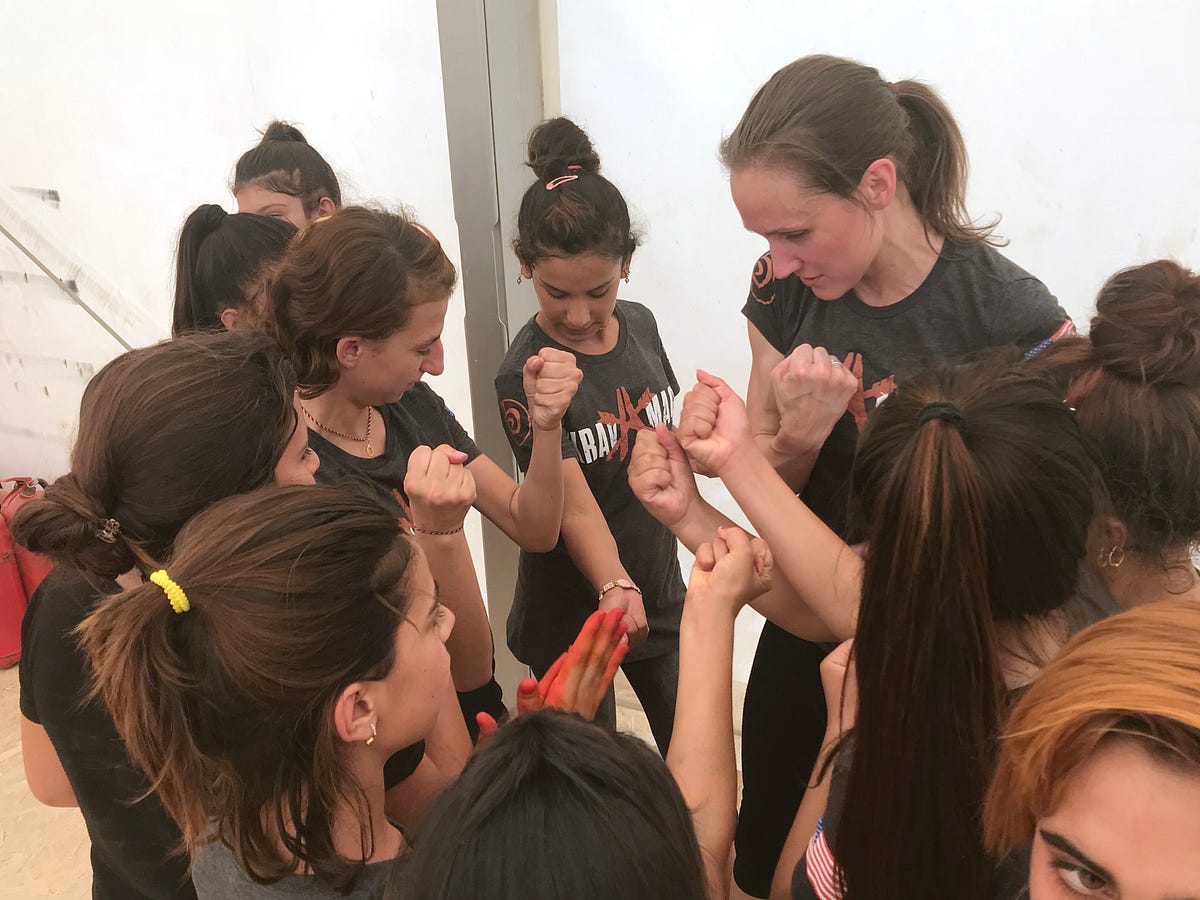 “I want you to tell everyone in America that these girls were treated like that by ISIS,” her father interjects, suddenly serious and intent. “When they were doing that to her, she was 13 years old.”
“I want you to tell everyone in America that these girls were treated like that by ISIS,” her father interjects, suddenly serious and intent. “When they were doing that to her, she was 13 years old.”
Seconds later, Rojin is again smiling and chatting with her sister. Asked what she’d like to do when she grows up, she says she isn’t sure. She knows only that she wants to make a difference. “I just love to help people,” she says.
For now, the lessons are over. Moore and his team are heading off to the next camp to begin a new set of lessons. But Moore promises to return to Rojin’s camp as soon as he can, once he raises the necessary funds. For now, he leaves her family with a striking pad so the girls can keep their skills up.
“Make sure you practice,” he tells them as he departs. They will. They promise.
*The names of the young women and their family members have been changed.